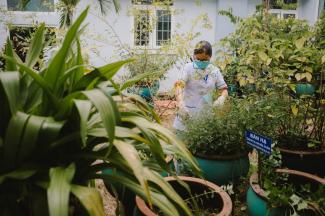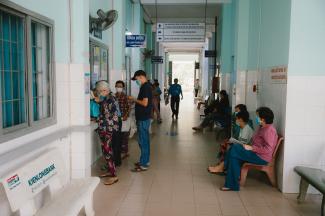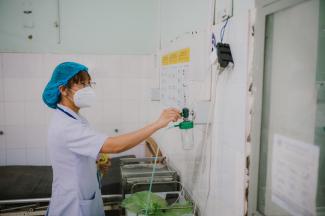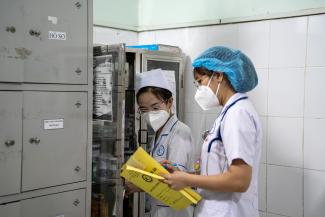Essential To Life
Strengthening Vietnam’s access to medical oxygen
Narrative by Angela Rucker, USAID | Video by Dave Cooper for USAID | Photos by Dave Cooper and Benjamin Ilka, USAID
November 2023

Dr. Thai Thi Hai Yen has a single goal when patients arrive at Dĩ An City Hospital: get them healthy enough to return home.
It’s not always a simple task for the infectious disease specialist.
The patients she sees in the working-class community about 12 miles from Ho Chi Minh City often require oxygen. That was certainly the case during the height of the COVID-19 pandemic, which killed at least 3 million people globally and more than 43,000 in Vietnam alone. Many patients were lucky to survive thanks to dramatic life-saving efforts inside hospitals.
Health care providers like Dr. Yen are celebrated for heroic work on the front lines of the devastating pandemic.
“Once we choose this career, it is the responsibility of medical staff to save patients’ lives,” she says, discouraging any talk of being a hero.
“In such a situation of [a] pandemic, it was imperative that everyone tried harder, encouraged themselves, and received encouragement from leaders to best complete their tasks.”

A safe and consistent supply of oxygen is vital to quality patient care, which the world saw first-hand during the pandemic.
After more than 18 months of successfully reducing transmission, Vietnam was hit hard by a second wave of COVID-19 in 2021. Hospitals quickly became overwhelmed with critical and severe COVID-19 patients, and their oxygen systems could no longer keep up with demand.
USAID and the Vietnam Ministry of Health developed a solution: installation of on-site tanks to store large quantities of oxygen in liquid form and piping to deliver the oxygen directly to patient bedsides.
When oxygen is stored at very low temperatures (-183 degrees Celsius), it takes a liquid form, allowing large amounts to be stored more safely and efficiently than in gaseous form.





“An oxygen cylinder weighs about 48 to 49 kilograms (about 100 pounds),” explains pharmacist Phu Duy Hoai Nam. “Every day (during the height of the pandemic), we transported between 180 and 200 tanks.”
And when he says “we,” he means everyone from pharmacists to doctors to nurses to support staff and even hospital administrators. Donning full personal protective equipment, often in extremely hot temperatures, everyone pitched in around the clock to save as many lives as possible.
Those days are over now.
Today, the hospital’s open-air corridors hum with the usual rhythm of emergency arrivals and routine appointments. It’s busy, but not hectic. It feels like a healing space with its medicinal garden overflowing with more than a dozen giant leafy green plants.



Dr. Ngo Hon Quang, the hospital’s acting director, says, “I am so delighted that this system has been successfully installed to provide oxygen to patients in need.”
He commends Dr. Yen, together with her peers, for showcasing “a high level of expertise” during the emergency phase of the pandemic. “She made use of the ventilators and oxygen system effectively. She helped save the lives of a lot of patients who were really near their deaths.”

USAID answered the call for oxygen in more than 50 countries during the pandemic, contributing over $100 million to expand access to oxygen in low- and middle-income countries.
This support is part of the Agency’s ongoing efforts to strengthen primary health care systems in countries around the world.
Dr. Yen says that oxygen plays an important role in saving lives during the pandemic and beyond. “It was quite a terrible time. Looking back at it, I feel very emotional,” she says.
Far from those harried days of COVID-19, Dr. Yen is, well, still really busy. There are studies for her post-graduate work. There’s balancing childcare duties with her husband, who is an emergency room doctor at the same hospital.
And there’s diagnosing and treating her patients, and mentoring colleagues as part of her new position as head of the hospital’s infectious disease department.



About This Story
Dĩ An City Hospital is one of 13 health care facilities in Vietnam where USAID supported the Vietnam Ministry of Health to install new liquid oxygen systems during the COVID-19 pandemic. These continue to improve clinical care today. An additional 10 liquid oxygen systems are set to be installed in facilities across Vietnam in the coming year along with additional training provided for staff.
For many patients, including those with COVID-19, medical oxygen is an essential medicine. Even in the absence of a pandemic, health care facilities like Dĩ An need medical oxygen to treat newborns, patients with severe pneumonia, people with chronic and infectious diseases, and patients requiring surgery.
A liquid oxygen system with piping to deliver oxygen directly to patient bedsides provides a higher concentration of pure oxygen and a more continuous and safer alternative to cylinder-based gaseous oxygen located within hospital wards—the common stopgap measure used during COVID’s peak in Vietnam.
USAID remains committed to combating the effects of COVID-19 and strengthening primary health care infrastructure in countries around the world.
Benjamin Ilka, Creative Advisor for USAID's Mission in Vietnam, and Cassandra Vasiloff, former Senior Communications Advisor for COVID-19 Response, contributed to this story.



